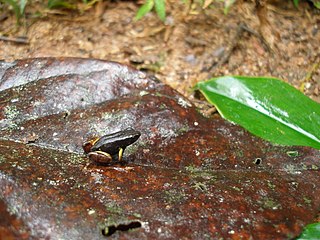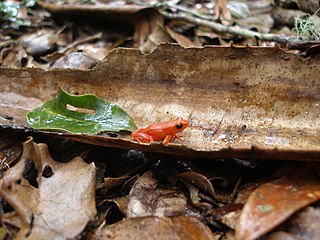Often compared to the Dart Poison Frogs in size, appearance and behavior, Mantellas are among the most highly desirable of all amphibian pets. Most are spectacularly colored – so much so that I’ve often had visitors to my exhibits at the Bronx Zoo ask if they are real! Indeed, many frog enthusiasts consider the ruby morph of the Golden Mantella (M. aurantiaca) to be the world’s most beautiful frog. Several of their colors, including some of the greens and oranges, are not seen in the more popularly-kept Dart Poison Frogs.
You can expect to see many interesting behaviors from Mantella Frogs, as they are active by day, quite bold, and are always foraging, exploring, interacting and otherwise “on the go”. Once considered delicate captives, several species are now regularly bred in captivity, and we are learning more about Mantella care and fascinating natural histories (including how they acquire their famous skin toxins…please see below) each year.The following information can be applied to most available species, including Painted, Golden, Green, Brown and Saffron Mantellas. However, details vary; please post below for information concerning individual species.
Natural History
The 16 frogs in the genus Mantella (family Mantellidae) are largely confined to Madagascar, although several inhabit Reunion and nearby islands. Mantellas measure ¾ to 1 ½ inches in length.
Brilliant colors warn predators that Mantellas can excrete powerful toxins when attacked. Entomologists from the California Academy of Sciences have discovered that Mantellas derive these toxins, or alkaloids, from their diet. The source of the toxins, at least for some species, is an endemic ant, Anochetus grandidieri. In an amazing example of parallel evolution, 13 of the toxic compounds found in Mantella skins are also utilized by unrelated Dart Poison Frogs, which feed upon unrelated ants, in Panama!
The Terrarium
Mantellas do best in terrariums stocked with live ferns, bromeliads, Philodendron and other plants. A densely-planted tank will provide you with many interesting observations, as the frogs will feel secure and behave normally.
A pair or trio can be kept in a 10 gallon aquarium; larger tanks can support small groups.
Mantella and Poison Frogs spend most of their lives on land and drown easily. One-half inch of de-chlorinated water should be provided in a shallow bowl or sloping pool. Hagen’s plastic Smart Plants hold small water reserves that make easily-exited pools for even the smallest species.
Mantellas can scale glass and will escape through even the tiniest of openings, so the terrarium’s cover must be secured with clips.
Substrate
A mix of coconut husk and a commercial rainforest substrate works well. Sheet or sphagnum moss should cover the surface to help retain moisture.
Light
Low levels of Ultra-Violet B light may be of some benefit. The Zoo Med 2.0 Low Output UVB Bulb is ideal. UVA may help to encourage natural behaviors, including reproduction. A number of UVA-emitting bulbs are now available (please post below for further information).
Heat
Mantellas generally dwell at high elevations or deep within forests, and require cooler temperatures than one might expect. They fare best at 68-76 F; most are stressed when temperatures exceed 80 F. Please post below for species-specific advice.
A fluorescent light may provide enough heat – if not, try a small incandescent bulb, but watch that the humidity remains high. A ceramic heater or reptile night bulb can be employed after dark.
Humidity
Humidity levels of 80 -100% should be maintained by keeping the moss layer damp and spraying the terrarium heavily. Small misters and humidity gauges are especially useful in arid homes and dry climates.
Feeding
A highly-varied diet is essential. Crickets alone, even if powdered with supplements, are not an adequate diet. As the largest Mantellas barely reach 1 ½ inches in length, providing a prper diet requires careful planning. Monitor your frogs closely – underfed individuals will exhibit protruding hip bones and flat stomachs.
The diet should be comprised of as many of the following food items as possible (please see the articles linked below for further information on rearing and collecting small insects):
Tiny flies, gnats and moths may be collected with the Zoo Med Bug Napper trap.
Flightless fruit flies: cultures are available commercially.
Pinhead/10 day old crickets.
Springtails: cultures available commercially, or collect below leaf litter.
Termites: collect in dead logs or via simple traps (please see article below)
Flour beetle larvae: available commercially.
Ants: experimenting required, as some species are rejected.
Aphids: tiny insects that colonize plant stems.
“Field Plankton”: insects gathered by sweeping through tall grass with a net.
Mantellas have large appetites and should be fed every day or two. One Brown Mantella was observed to eat 53 ants in 30 minutes!
Important food supplements include Zoo Med ReptiCalcium or a similar product (most meals) and a vitamin supplement (ReptiVite with D3) 3 times weekly.
Companions
Most can be kept in single or multiple species groups, but both sexes can be territorial. Sight barriers (plants, logs) will help, but care must be taken that dominant individuals do not monopolize food or stress others.
Handling
Mantellas are tiny, quick, and easily stressed. They are best considered as animals to observe, not handle, and should be moved by being urged into a plastic container.
Individuals that feed upon typical captive diets are not able to synthesize skin toxins. However, other skin secretions transferred to wounds, eyes, or the mouth may cause irritations.
 That Reptile Blog – Reptile, Amphibian and Exotic Pet Care and Information
That Reptile Blog – Reptile, Amphibian and Exotic Pet Care and Information






Excellent article! Kudos from a Mantella caretaker.
Thanks very much for the kind words! Any comments/observations you have time to post would be most appreciated, best, Frank
This was very informative. I had wondered what other types of food sources I could feed my mantella other than fruit flies & crickets…and now I know! Thanks.
Thanks for the kind words, Tim; let me know if you try any or need any more info, enjoy, Frank